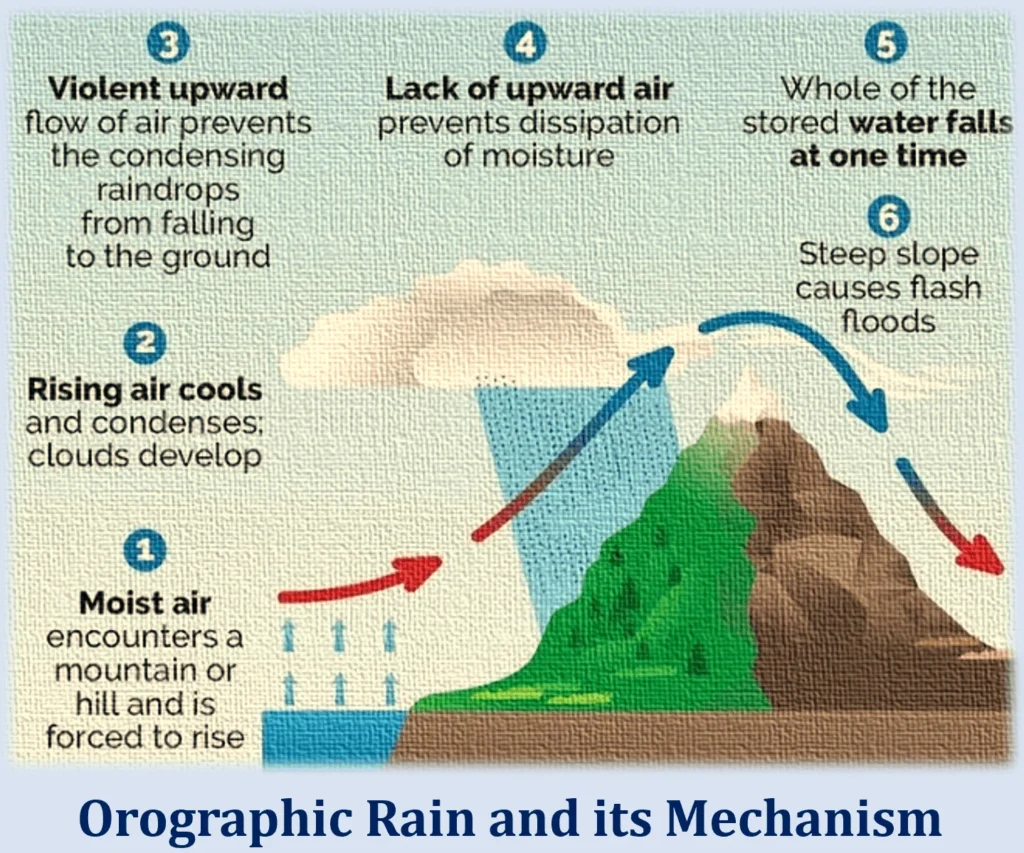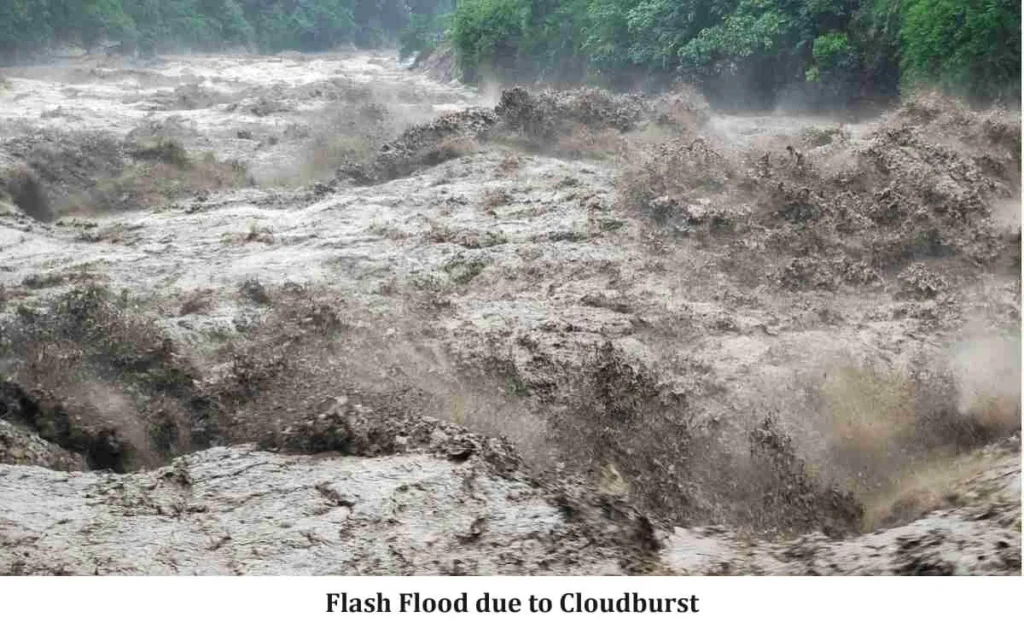
Cloud bursts are brief periods of extremely heavy rainfall that happen all of a sudden. This implies that a lot of rain falls suddenly from the sky, frequently overloading the local drainage systems. These intense downpours can lead to floods and other related problems. Studying then is crucial because they have the potential to do a lot of harm and researching them enables us to develop methods for foreseeing and avoiding their negative impacts. Therefore, we must understand their origins, how they impact us, and how to forecast and prevent them from doing us damage.
Understanding the Science Behind Cloud Bursts
Overview of Atmospheric Conditions
The formation of clouds is greatly influenced by temperature. The rising air has the tendency to cool down. When it reaches the dew point temperature the water vapor present in it condenses into tiny droplets or ice crystals forming clouds. More water vapor is accessible for the formation of clouds as more moisture is present in the air with higher humidity levels.
Characteristics of Cloud Bursts
An abrupt buildup of water vapor in the sky during a cloud burst causes the creation of huge, thick clouds. Heavy rainfall occurs as a result of these clouds losing all of their ability to retain moisture. The swift and intense nature of this rainfall distinguishes cloud bursts from regular rainfall patterns.
Historical Perspective of Cloud Bursts
Noteworthy Cloud Burst Events Throughout History
Throughout history, there have been several significant cloudburst occurrences that have left a lasting impact. From the Johnstown Flood in 1889 to the most recent flood in Sikkim 2023 where 23 army personnel went missing. These events have caused immense destruction to human settlements and infrastructure, resulting in significant loss of life and economic damage.
Lessons Learned from Past Incidents
As a result of these devastating events, valuable lessons have been learned. Early warning systems have been developed to provide timely alerts to communities at risk of cloud bursts. Additionally, mitigation strategies, such as the construction of flood-resistant infrastructure and the identification of vulnerable areas, have been implemented to reduce the impact of future incidents.
Factors Contributing to Cloud Bursts
Topographic Influences
Mountainous regions play a crucial role in cloud burst formation. The upward motion of air as it encounters the mountains acts as a trigger for cloud development and subsequent heavy rainfall. Additionally, the unique geography of valley systems can lead to the condensation of moisture, further exacerbating the potential for cloud bursts.

Climate Change and Cloud Bursts
A rising amount of research points to a link between global warming and an increase in cloud burst frequency. The danger of these extreme weather events rises as a result of changing precipitation patterns and exacerbated atmospheric conditions brought on by ongoing climate change.
Mechanisms of Cloud Burst Formation
Inspecting Moisture Sources
Moisture plays a critical role in cloud burst formation, with contributions from sources such as oceans and lakes. The proximity of these bodies of water to landmasses, as well as seasonal patterns like monsoons, greatly influence the availability of moisture in the atmosphere, providing the necessary ingredients for cloud burst formation.
Role of Atmospheric Dynamics
The upward motion of air, known as atmospheric convection, is a key factor in cloud development and subsequent cloud bursts. As moist air rises and condenses, it forms towering cumulonimbus clouds, capable of releasing copious amounts of rainfall. Jet streams, high-altitude air currents, can also impact cloud bursts by influencing the movement and intensity of storm systems.
Impacts of Cloud Bursts
Urban Areas and Infrastructure Damage
Cloud bursts pose significant risks to urban areas, often leading to severe flooding and extensive damage to infrastructure. Overflowing rivers and overwhelmed drainage systems result in inundation of streets and buildings, disrupting transportation systems and causing financial losses.

Ecological Consequences
The ecological consequences of cloud bursts are far-reaching. The heavy rainfall can lead to soil erosion, depleting fertile topsoil and affecting agricultural productivity. Vegetation can be uprooted or destroyed, disrupting ecosystems and further exacerbating erosion. Aquatic ecosystems also suffer as excessive runoff carries pollutants into water bodies, harming aquatic life.
Analyzing the Societal Impact of Cloud Bursts
Human Casualties and Displacement
They often result in the loss of human life and injuries. The suddenness and intensity of the rainfall make it challenging for individuals to seek safety, leading to tragic consequences. Communities affected by cloud bursts may also face displacement and require rehabilitation measures to recover and rebuild their lives.
Economic Repercussions
The economic impacts of cloud bursts are substantial. Significant damage can be done to commercial and agricultural operations, resulting in financial losses and interruptions to the local economy. The expenses of recovery and reconstruction, such as making repairs to the infrastructure and giving relief to the impacted people, may be high and protracted.
Forecasting and Early Warning Systems
Advancements in Cloud Burst Prediction
Advancements in data gathering and analysis techniques, including the utilization of weather models and simulations, have improved the accuracy of cloud burst prediction. By monitoring atmospheric conditions, scientists can identify the potential for cloud burst formation and provide early warnings to at-risk communities.
Importance of Early Warning Systems
Early warning systems play a vital role in alerting communities and preventing loss of life during cloud bursts. These systems provide timely information and guidance on evacuation procedures, allowing individuals to seek safety before the onset of heavy rainfall. Preparedness measures, such as educating the public and conducting drills, further enhance the effectiveness of early warning systems.
Mitigation Strategies for Vulnerable Areas
Infrastructure Measures
In areas prone to cloud bursts, implementing specific construction techniques can help minimize damage. Flood-prone regions can benefit from the construction of elevated structures and the incorporation of flood-resistant materials. Additionally, designing sustainable drainage systems can improve the management of excess water during intense rainfall events.
Enhancing Natural Resilience
Restoring and enhancing natural resilience can also mitigate the impact of cloud bursts. Reforestation efforts help stabilize slopes, reduce erosion, and promote water absorption in the soil. Similarly, the preservation and creation of wetlands can serve as natural retention areas, slowing down the movement of water during heavy rainfall events.
International Collaboration and Research
Sharing Knowledge and Experiences
Meteorological organizations and research institutions play a crucial role in sharing knowledge and experiences related to cloud bursts. Collaboration between countries and the creation of global cloud burst databases enable the exchange of valuable information, helping to improve prediction accuracy and response strategies.
Future Research Prospects
As they continue to pose significant threats, future research focuses on improving prediction accuracy and evaluating the long-term implications of climate change on their frequency and intensity. By expanding our knowledge and understanding, we can better equip ourselves to mitigate the risks associated with these unpredictable weather phenomena.
Conclusion
In summary, cloud bursts are unforeseen weather phenomena characterized by intense and heavy rainfall over a short period. Understanding their science, historical perspectives, and impacts is crucial for effective prediction, mitigation, and preparedness. Working on technologies like early warning system can help us reduce the devastating effect of cloudbursts. Whereby we can protect the lives of many.
Frequently Asked Questions (FAQs)
- What is the difference between cloud bursts and regular rainfall?
Cloud bursts are characterized by their intensity and rapid accumulation of rainfall, while regular rainfall occurs over a more extended period and with lesser intensity.
- Can cloud bursts be predicted accurately?
Advancements in prediction techniques have improved accuracy, but the unpredictable nature of cloud bursts presents challenges in achieving complete accuracy.
- How long can a cloud burst event last?
Cloud bursts can last anywhere from a few minutes to a few hours, depending on atmospheric conditions and the availability of moisture.
- Are certain regions more prone to cloud bursts?
Mountainous regions and areas with high humidity levels are more susceptible to cloud bursts. However, they can occur in various geographical locations.
- What can individuals do to protect themselves during a cloud burst?
Seek shelter in sturdy buildings, avoid flooded areas, and stay updated with local weather forecasts and evacuation procedures.
